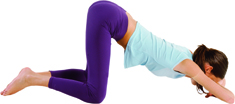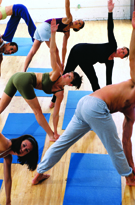Harmonizing yoga
In Sanskrit means harmonizing your body, spirit and mind. Yoga exercises work on all the various systems of the body and provide a number of benefits for women; helping to relieve discomforts brought on by menstruation, pregnancy and menopause.

+ During the different cycles of the menstrual periods, pregnancy and menopause, women undergo an important number of changes in the production of estrogen, progesterone and calcium metabolizing. There are a number of yoga poses that help to balance these functions, helping to maintain bone density. Also, they help to regulate ovary function and hypothalamus and pituitary glands, which control the endocrine system, generating menopause.
1. Lie down with your legs together and your forehead rested on the palms of your hands on the floor. Your legs should be straight with the front of your feet resting on the floor. Press your buttocks to help you move into the next position and place your elbows, forearms and the palms of your hands on the floor. Your elbows should stay at the same height as your shoulders and your head pressed against the floor.
THE COBRA
This asana is beneficial for the female body because it regulates the suprarenal glands’ function and strengthens the back, increases the flexibility of the spine and helps to tone the abdominal muscles. In addition, it helps to increase your energy and to lift up your self-esteem. It helps to regulate your menstrual period and relieves tension, but it shouldn't be practiced while you are menstruating.

2. Lift up your chest, always with your buttocks contracted. So as not to harm the neck, extend your arms at the same time as you lift up your chest. If this causes any discomfort, don't strain yourself and keep your head looking forward. Breathe normally. To release, slowly lower your body while you place on the ground (in this order): the abdomen, the chest and lastly the chin, always stretched forward. Next, bring your chin downward and rest one cheek on the ground.
SHOULDER STAND
This asana is recommended for discomforts caused by premenstrual syndrome, because it regulates blood circulation throughout the body, relieving tension and pain. Do not practice this pose while you are menstruating.
Lie down on the floor with your legs together and your hands, palms down, by your sides. Inhaling, push down on your hands and raise your legs straight up above you; exhale. As you inhale lift your hips off the floor and bring your legs up, over and beyond your head, at an angle of about 45 degrees. Exhaling, bend your arms and support your body, holding as near the shoulders as possible, thumbs around the front of the body, fingers around the back. Push your back up, try to lift your legs to a near vertical position. Stay in this position for as long as you feel comfortable, breathing slowly and deeply in the pose.

CAT POSE
This asana is ideal to help relieve abdominal pain during PMS and your period. It is also ideal for pains during pregnancy.
Start on your hands and knees, with your knees fully spread. Move your hips back, fold your arms and place your forehead on your arms, leaving your buttocks pointed upward. Breathe slowly and deeply, relaxing your entire body.

Another variation that may be more comfortable and relieves pain. Start from the previous position, bring together your ankles and sit on them with your elbows pressed to the floor. asana Stay in this asana for as long as you feel comfortable, breathing naturally and deeply, looking for maximum relaxation.

YOGA FOR EVERY STAGE OF LIFE
- • For premenstrual syndrome and menstrual cramps. During the first two days of menstruation, it's best to only do breathing and relaxation exercises. You should not do upside down poses while menstruating.
- • During pregnancy. Yoga is a gentle way of keeping your body active and supple and minimizes the common pregnancy symptoms like morning sickness and constipation. As long as you aren't experiencing bleeding or any other medical complication, you can practice yoga without problems during pregnancy. It also helps in restoring your body shape, uterus, abdomen, and pelvic floor, and in relieving upper back tension and breast discomfort after childbirth. The Pranayama breathing techniques can also become handy during labor, and improve circulation for mother and baby, helping both to relax. You should avoid poses that work the glandular parts of the body. Special care, however, is needed in choosing the yoga poses that you will practice, you should avoid poses that require an inverted position or laying on the belly.
- • During menopause. This is one of the most beneficial physical exercises and the least risky. Practicing yoga after 50 years of age helps to keep you physically fit, mentally healthy and to avoid a sedentary lifestyle.
GENTLE EXERCISE
Yoga is a discipline designed to improve your flexibility and harmony. The exercises use gentle movements without straining your body. When practicing the asanas remember not to strain yourself. There is no need to push yourself too far. Remember to use gentle movements and don't push your body into a pose.
YOGA POSE FOR MENOPAUSE. THE TRIANGLE POSE

This is the asana most widely used in the prevention of osteoporosis. It's advised to practice this pose at any age, but especially during menopause. It gives an excellent lateral stretch to the spine, toning the spinal nerves and abdominal muscles. It also strengthens the legs, reducing the probability of a fractured hip. In addition, it balances your body, making the muscles and joints more flexible, especially in the pelvic region. If your body isn't very flexible, use a wall for extra support.
Safety. Do not practice this pose if you suffer from meniscus, herniated disk or hip problems.
1. Stand with your feet well apart. Raise your arms parallel to the floor and reach them to the sides, shoulder blades wide, palms down. Without bending your knees, extend your torso and turn your right foot out.
2. As you inhale, bend your torso to the right and bring both hands to your right ankle (or shin, depending on how flexible you are). Extend your right arm toward the ceiling with your palm facing away from you. Look out at your right hand. Take several full breaths in this position before releasing it. Release and repeat, bending to the other side.

Comment about this article, ask questions, or add new information about this topic: